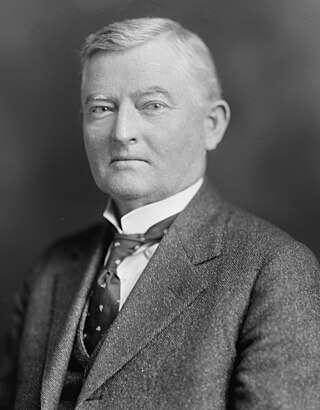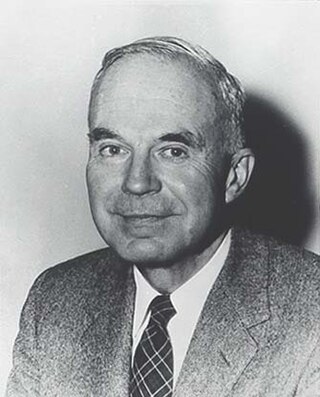Related Research Articles

John Nance Garner III, known among his contemporaries as "Cactus Jack", was an American politician and lawyer who served as the 32nd vice president of the United States from 1933 to 1941 under President Franklin D. Roosevelt. A member of the Democratic Party, Garner served as the 39th speaker of the United States House of Representatives from 1931 to 1933, having been a United States representative from Texas from 1903 to 1933. Garner and Schuyler Colfax are the only politicians to have served as presiding officers of both chambers of the United States Congress — as speaker of the House and vice president of the United States.

James Albert Michener was an American writer. He wrote more than 40 books, most of which were long, fictional family sagas covering the lives of many generations, set in particular geographic locales and incorporating detailed history. Many of his works were bestsellers and were chosen by the Book of the Month Club. He was also known for the meticulous research that went into his books.

The Missouri–Kansas–Texas Railroad was a Class I railroad company in the United States, with its last headquarters in Dallas, Texas. Established in 1865 under the name Union Pacific Railroad (UP), Southern Branch, it came to serve an extensive rail network in Texas, Oklahoma, Kansas, and Missouri. In 1988, it merged with the Missouri Pacific Railroad; today, it is part of UP.

Dolph Briscoe Jr. was an American rancher and businessman from Uvalde, Texas, who was the 41st governor of Texas between 1973 and 1979. He was a member of the Democratic Party.

Jack Bascom Brooks was an American Democratic Party politician from the state of Texas who served 42 years in the United States House of Representatives, initially representing Texas's 2nd congressional district from 1953 through 1967, and then, after district boundaries were redrawn in 1966, the 9th district from 1967 to 1995. He had strong political ties to other prominent Texas Democrats, including Speaker of the House Sam Rayburn and President Lyndon B. Johnson. For over fifteen years, he was the dean of the Texas congressional delegation.

Henry Barbosa González was an American Democratic politician from the U.S. state of Texas, who represented Texas's 20th congressional district from 1961 to 1999. He is the longest serving Hispanic in Congress and a founding member of the Congressional Hispanic Caucus.

The Battle of Cape Girardeau was a military demonstration of the American Civil War, occurring on April 26, 1863 in Cape Girardeau, Missouri. The conflict was part of the pursuit of US Brigadier General John McNeil through Southeast Missouri by Confederate Brigadier General John S. Marmaduke. Though the conflict to this day is known as a battle, it was a relatively small engagement whose primary importance was as the turning point that brought General Marmaduke's second Missouri raid to an end.

Walker Kirtland Hancock was an American sculptor and teacher. He created notable monumental sculptures, including the Pennsylvania Railroad World War II Memorial (1950–52) at 30th Street Station in Philadelphia, and the World War I Soldiers' Memorial (1936–38) in St. Louis, Missouri. He made major additions to the National Cathedral in Washington, D.C., including Christ in Majesty (1972), the bas relief over the High Altar. Works by him are presently housed at the U.S. Military Academy at West Point, the Library of Congress, the U.S. Supreme Court, and the United States Capitol.

Mary Frances Tarlton "Sissy" Farenthold was an American politician, attorney, activist, and educator. She was best known for her two campaigns for governor of Texas in 1972 and 1974, and for being placed in nomination for vice president of the United States, finishing second at the 1972 Democratic National Convention. She was elected as the first chair of the National Women's Political Caucus in 1973.

The Southgate–Lewis House is a historic landmark located one mile east of the Texas State Capitol in Austin, Texas. The Southgate–Lewis House is located in the center of the east Austin "African American Cultural Heritage District".

R.C. Hickman was an American photographer, photojournalist and circulation manager, known for his photographs of the Civil Rights Movement. Hickman's work includes documenting the Mansfield school desegregation incident, as well as the visitation of people such as Martin Luther King Jr. and Ella Fitzgerald in Dallas, Texas. For many decades he worked as a photographer for the Dallas Star Post as well as freelancing for Jet, Ebony and an array of other African-American magazine publications.
Thomas M. Hatfield is an American historian. He is a senior research fellow at the Dolph Briscoe Center for American History at the University of Texas at Austin, and director of its Military History Institute. He was previously dean of continuing education at the university, from 1977 to 2007. He contributed to the establishment of both the John Tyler Community College in Richmond, Virginia and the Austin Community College in Austin, Texas, and was among the founders of the Normandy Scholars Program at the University of Texas at Austin.

Emily Austin Bryan Perry was the sister of Stephen F. Austin and an early settler of Texas. She was an heir to Austin's estate when he died in 1836. She achieved significant political, economic and social status as a woman in Texas at a time when women were often not treated equal to men.
James Bryan (1789–1822) was an American mining entrepreneur whose efforts in concert with others brought economic development to Missouri. Bryan operated "Bryan's Mines" on Hazel Run, north of Big River, in SW 1/4 of Sec. 33, T. 37N. 5E. in 1806; this location is also known as "Hazel Run Lead Digging."
Stephen Samuel Perry (1825–1874) was an American early settler and pioneer of the state of Texas. He had managed the Peach Point Plantation, and he is credited with amassing and preserving significant historical manuscripts related to Texas history.

The Dolph Briscoe Center for American History is an organized research unit and public service component of the University of Texas at Austin named for Dolph Briscoe, the 41st governor of Texas. The center collects and preserves documents and artifacts of key themes in Texas and United States history and makes the items available to researchers. The center also has permanent, touring, and online exhibits available to the public. The center's divisions include Research and Collections, the Sam Rayburn Museum, the Briscoe-Garner Museum, and Winedale.

George Washington Brackenridge was a philanthropist and the longest-serving Regent for the University of Texas. His donations of time, land holdings and wealth expanded the university and provided educational opportunities for women and other minorities. He was an advocate of women's suffrage and women's educational opportunities. He was also a business man who made his initial wealth as a profiteer during the Civil War. Brackenridge organized two banking institutions in San Antonio and served as their president. He was president of the San Antonio Water Works Company. Alamo Heights in Bexar County was once his residence and was named by him. His mansion Fernridge is now part of University of the Incarnate Word campus. Brackenridge Park, San Antonio Japanese Tea Garden and Mahncke Park in San Antonio were made possible through his donations of land holdings.
The Archives of American Mathematics, located at the University of Texas at Austin, aims to collect, preserve, and provide access to the papers principally of American mathematicians and the records of American mathematical organizations.

Eugene Campbell Barker was an American historian at the University of Texas, the managing director of the Texas State Historical Association, and the editor of the Southwestern Historical Quarterly. He chaired the history department while soliciting gifts to the university, which he used to build a collection of archives and artifacts. In 1950, the university dedicated the Eugene C. Barker History Center as a repository for his collections. These collections are an important part of the Dolph Briscoe Center for American History at the University of Texas.
W. R. (Robert) Sullivan was the inventor of an early hummingbird feeder as well as an advocate for banding hummingbirds and hummingbirds living in zoos.
References
- 1 2 3 4 5 6 7 8 Hults, Molly. "John E. Sunder Journals". Austin History Center. Archived from the original on 2016-03-04. Retrieved 28 October 2012.
- ↑ Sunder, PFC John E., United States Army, "Disease Fighters in Korea: Preventive Maintenance Teams Aids Health of U.S. Forces and Koreans", Pacific Stars and Stripes , Tokyo, Japan, volume 11, number 255, September 13, 1955, Features section, pages 6-7. (subscription required)
- 1 2 3 4 "John E. "Jack" Sunder". Obituary. Austin American-Statesman. Retrieved 28 October 2012.
- ↑ Usler, Evan. "A Guide to the John E. Sunder Papers, 1945-1996". Texas Archival Resources Online. Retrieved 28 October 2012.
- ↑ "Sunder (John E.) Texas Slide Collection, 1956-1974". Texas Archival Resources Online. Briscoe Center for American History. Retrieved 28 October 2012.
- ↑ Schmuland, Arlene. "Guide to the John E. Sunder slides". Historical Manuscripts Collection List. University of Alaska. Retrieved 28 October 2012.